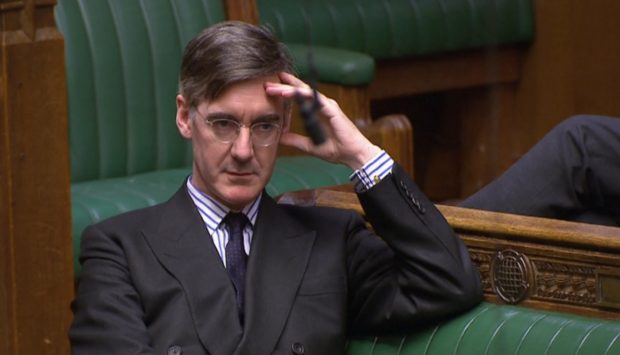I always thought there must be some esoteric purpose to Jacob Rees-Mogg but for the life of me, could never work out what it was.
Unless it was to remind us all what 1950s Britain looked and sounded like because, post Brexit, we would all be back there eating potted meat and singing Land of Hope and Glory. But the mystery is now solved. Rees-Mogg exists to instruct us on style.
Not clothes, I hasten to add – but then, I think you knew that already. No, a kind of gentleman’s guide to the Queen’s English that would sit as the perfect companion to the manual on the perfect trouser crease on the toff’s book shelf.
As a writer, I obviously care about words. They can be playful, penetrating, harsh or compassionate. They can raise spirits or destroy souls. I like to see them used well – and correctly. But when I read Rees-Mogg’s style guide in the same week that the Social Metrics Commission announced that four million people in Britain are living in deep poverty – which means their incomes are 50% below the official breadline – it grated deeply.
The beauty of words is their potential to build bridges. Words allow us to know that what you think, I also think; or what I feel, you feel. They enable discussion, negotiation, and compromise. Strange, then, that Rees-Mogg uses them as a social divider. There is nothing wrong with the words he outlaws, yet he attempts to use them as a badge, a way of distinguishing the intelligentsia who wouldn’t dream of using them from the ignorant plebs who would.
So, what is banned in Rees-Mogg’s linguistic rules? “Very” and “unacceptable” for a start. Why? Well, it’s obvious innit? They’re Nooo Labour words, Jacob says, and therefore removed from the lexicon. Also out are “got”, “lot” (sorry, no idea…), “fit for purpose”, “I am pleased to learn”, “ascertain”, “disappointment”, “speculate”, “I note/ understand your concerns” … oh, and commas after ‘and’. I am sorry but a comma after and, in some instances, is perfectly correct.
Remember in primary school when you were given a list of words and asked to write a paragraph containing as many as possible and you just ended up with gobbledygook?
“Dear Jacob, I NOTE YOUR CONCERNS regarding language that you no longer consider FIT FOR PURPOSE but I feel DISAPPOINTMENT at your attitude. I have GOT a LOT of reservations about your list and, as I don’t wish to SPECULATE about your reasoning, I would like to question you further to ASCERTAIN why you object to grammatically correct constructions and perfectly legitimate words.”
Like “equal” which is also on the banned list. Don’t like the concept? Just ditch the word. There is something deeply troubling about the new government’s makeup that goes beyond politics and policy. There has, of course, always been a ruling ‘elite’ in Britain with an historic link between the aristocracy and politics. But there is a deliberate affectation at play right now, with the ex-Bullingdon club Prime Minister playing Boris the buffoon and Rees-Mogg, leader of the House of Commons acting like Lord Snooty at a Victorian peasants’ picnic.
It is not that Rees-Mogg and his ilk are posh that troubles me. Or rich. I have no quibble with his personal fortune which guesstimates have put between £55 million and £150 million. It’s the fact he tries so hard to distance himself from those he represents that offends me. He is not, he has told us in the past, “a modern man.” I’ll say. He has never ironed a short, owned a pair of jeans, or, despite having six children, changed a nappy. He leaves that sort of thing to the nanny. (The same one he had.)
I shouldn’t have an opinion that his sons are called Sixtus Dominic Boniface Christopher (yes, all that for one wee boy) and Alfred Wulfric Leyson Pius, but Rees-Mogg certainly has an opinion on lexical choices, and anyway, God help them all when they leave Eton. And how unnerving to see the pictures of Rees-Mogg with 11-year-old son Peter Theodore Alphege, nicknamed Mini-Mogg because he sports the same glasses and haircut as his father and is dressed identically, whether it’s in oversized tweed jacket and tie, or pinstripe suit.
If Rees-Mogg wants to start pontificating about the murder of the English language, maybe he should start with the Prime Minister. Language should have meaning and clarity but Boris is the Russell Brand of politics, spewing out words with the speed of a train accelerating out of the station with no idea of its destination, and finally derailing in the middle of nowhere.
Maybe-Rees-Mogg should re-instate the word “equal”; focus on clarity; and encourage consideration of words like poverty, justice and community. Certainly, it would be best to leave the exclusion of redundant words to people who know something about it, like dictionary compilers. Which reminds me: I was interested to note that the word “tosser” is now included in the Oxford and Cambridge dictionaries. Just sayin’…
Catherine Deveney is an award-winning investigative journalist, novelist and television presenter

